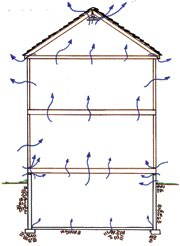303-888-2667
 You wouldn’t leave a window open on a cold night during winter with the furnace going full tilt – or on a warm day in summer while running the AC. But that’s exactly what you’re doing if you haven’t air sealed your home!
You wouldn’t leave a window open on a cold night during winter with the furnace going full tilt – or on a warm day in summer while running the AC. But that’s exactly what you’re doing if you haven’t air sealed your home! Understanding the “Stack Effect” – The laws of convection cause warm air in your house to rise. As it rises, it moves up through the attic, passing through dozens of cracks and exposed openings. As this air is lost, new air is pulled in from the crawl space, basement, and outside, only to be heated again and lost again. This cycle of air ex-filtrating from the top and infiltrating from the bottom is known as the “stack effect”.
Understanding the “Stack Effect” – The laws of convection cause warm air in your house to rise. As it rises, it moves up through the attic, passing through dozens of cracks and exposed openings. As this air is lost, new air is pulled in from the crawl space, basement, and outside, only to be heated again and lost again. This cycle of air ex-filtrating from the top and infiltrating from the bottom is known as the “stack effect”.
